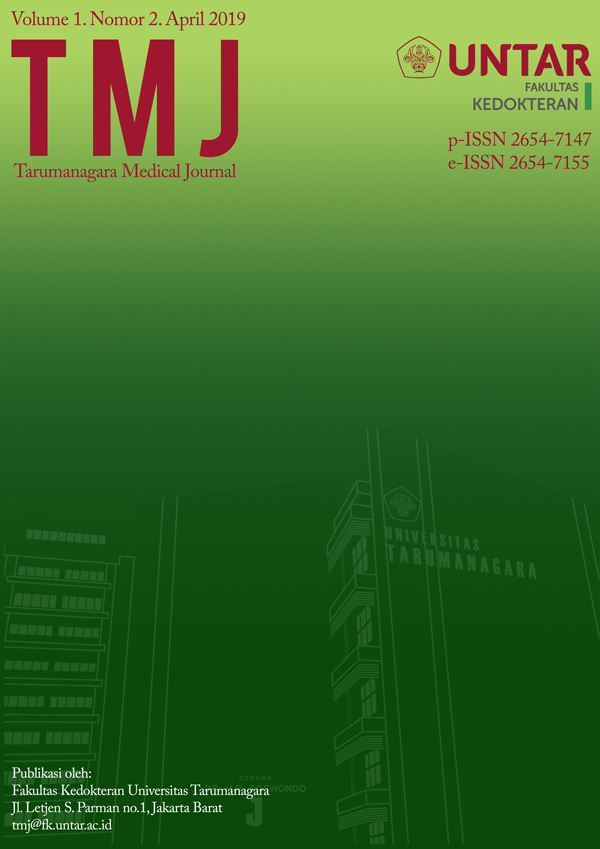Uji fitokimia dan efek buah ara (Ficus carica l.) terhadap kadar malondialdehid (MDA) darah dan otak tikus Sprague dawley yang diinduksi hipoksia sistemik kronik
Main Article Content
Abstract
Pasokan aliran oksigen yang cukup dan konsisten diperlukan oleh otak. Keadaan hipoksia dapat menyebabkan stres oksidatif yang berakibat pada gangguan serius. Stres oksidatif dapat ditekan dengan pertahanan antioksidan yang melebihi produksi Reactive Oxygen Species (ROS). Buah ara (Ficus carica L.) merupakan tumbuhan obat yang sangat menjanjikan manfaatnya karena kandungan senyawa fitokimianya memiliki kapasitas antioksidan alami yang kuat dan potensial yang pada akhirnya dapat menangani berbagai masalah kesehatan; kanker, penyakit pembuluh darah dan saraf. Uji fitokimia yang dilakukan pada buah ara segar (Ficus carica L.). Tikus Spargue dawley dibagi menjadi 4 kelompok (n=8/kelompok) dengan masing-masing kelompok dibagi lagi menjadi 2 subkelompok (n=4/subkelompok) dengan pemberian dosis buah ara yang berbeda kemudian semua tikus dilakukan perlakuan hipoksia (8% O2) selama 1 hari, 3 hari dan 7 hari kecuali kelompok kontrol (normoksia). Sampel darah dan otak digunakan untuk mengukur kadar MDA dengan metode Wills, analisa gas darah dan hematologi. Buah ara (Ficus carica L.) mengandung senyawa fitokimia golongan alkaloid, fenolik, flavonoid dan triterpenoid. Kadar MDA darah dan otak pada kedua kelompok tikus dengan pemberian dosis buah ara sesuai ketentuan meningkat bermakna jika dibandingkan dengan kelompok kontrol (p<0.05) dan memiliki korelasi kuat. Berdasarkan analisa gas darah dan hematologi;pO2, pCO2, HCO3 dan saturasi O2 menurun, sementara semua parameter hematologi meningkat. Buah ara dapat menekan stres oksidatif dan mengurangi terjadinya kerusakan lipid akibat hipoksia yang dinyatakan dalam kadar MDA.
Article Details
Penulis yang menerbitkan artikelnya di Tarumanagara Medical Journal (TMJ) setuju dengan ketentuan sebagai berikut:
- Penulis mempertahankan hak cipta dan memberikan jurnal hak publikasi pertama dengan bekerja secara bersamaan dilisensikan di bawah Creative Commons Attribution yang memungkinkan orang lain untuk berbagi karya dengan pengakuan atas kepengarangan dari karya asli dan publikasi dalam jurnal ini.
- Penulis dapat masuk ke dalam pengaturan kontrak tambahan yang terpisah untuk distribusi non-eksklusif jurnal versi pekerjaan yang dipublikasikan (misalnya, memposting ke repositori institusional atau menerbitkannya dalam buku), dengan pengakuan publikasi awal dalam jurnal ini.
- Setiap teks yang dikirim harus disertai dengan "Perjanjian Transfer Hak Cipta" yang dapat diunduh melalui tautan berikut: Unduh
References
Yuwono A. Hari keanekaragaman hayati [Internet]. Jakarta: Kementrian Lingkungan Hidup Republik Indonesia; 2013 Mei 22 [cited 2015 Oct 10]. Available from: http://www.menlh.go.id/hari-keanekaragaman-hayati-22-mei-2013/
Plant species number [Internet]. Botanic Gardens Conservation International; 2010 [cited 2015 Oct 10]. Available from: https://www.bgci.org/policy/1521/
FAO. Medicinal plants for forest conservation and health care [Internet]. Rome: Food And Agriculture Organization Of The United Nations; 1997 [cited 2015 Oct 10]; [about 1 screen]. Available from: http://www.fao.org/3/a-w7261e.pdf
Chang CC, Yang MH, Wen HM. & Hern JC. 2002. Estimation of Total Flavonoid Content in Propolis by Two Complementary Colorimetric Methods. Journal of Food and Drug Analysis 10 2002, pp 178-182.
Kurdi A. Tanaman herbal Indonesia [Internet]. 2010 [cited 2015 Oct 10]; [about 2 screens]. Available from: https://aseranikurdi.files.com/2011/09/tanaman-herbal.pdf
Rashid KI, Mahdi NM, Alwan MA, Khalid LM. Antimicrobial activity of fig (Ficus carica Linn.) leaf extract as compared with latex extract against selected bacteria and fungi. Journal of Babylon University [Internet]. 2014 [cited 2015 Oct 10];22(5):1-2. Available from: www.iasj.net/iasj?func=fulltext&aId=88512
El-Shobaki FA, El-Bahay AM, Esmail RSA, Abd El Megeid AA, Esmail NS. Effect of figs fruit (Ficus carica L.) and its leaves on hyperglycemia in alloxan diabetic rats. World J of Dairy & Food Science [Internet]. 2010 [cited 2015 Oct 10];5(1):1-2. Available from: www.idosi.org/wjdfs/wjdfs5(1)/8.pdf
Haug MT, King ES, Heymann H, Crisoto CH. Sensory profiles for dried fig (Ficus carica L.) cultivars commercially grown and processed in California. J of Food Science [Internet]. 2013 [cited 2015 Oct 10];78(8):1-2. Available from: www.ncbi.nlm.nih.gov/pubmed/23957419
Crisoto CH, Bremer V, Ferguson L, Crisoto GM. Evaluating quality attributes of four fresh fig (Ficus carica L.) cultivars harvested at two maturity stages. J of Food Science [Internet]. 2010[cited 2015 Oct 10];45(4):1-2. Available from: www.ucanr.edu/datastoreFiles/234-1581.pdf
Joseph B, Justin SJ. Pharmacognostic and phytochemical properties of Ficus carica Linn—An overview. Int J of PharmTech [Internet]. 2011 Jan [cited 2015 Oct 11];3(1):1-3. Available from: www.sphinxsai.com/Vol.3No.1/pharm_jan-mar11/pdf
Tawfik MS, Alhejy M. Antioxidants in fig (Ficus carica L.) and their effects in the prevention of atherosclerosis in hamsters. J of food and nutrition sciences [Internet]. 2014 Jul [cited 2015 Oct 11];2(4):1-2. Available from: www.sciencepublishinggroup.com/journal/paperinfo.aspx
Semenza GL. American journal of physiology—Cell physiology theme: hypoxia. American J of Physiology [Internet]. 2011 Feb [cited 2015 Oct 12];300(2):1-2. Available from: http://ajpcell.physiology.org/content/300/2/C225
Family Caregiver Alliance. Hypoxic brain injury [Internet]. San Francisco; 2004 Dec [cited 2015 Oct 12]. Available from: https://www.caregiver.org/hypoxic-anoxic-brain-injury
Pialoux V, Mounier R. Hypoxia-induced oxidative stress in health disorders. Hindawi Publishing Corporation [Internet]. 2012 [cited 2015 Oct 12];2012: Article ID 940121:1-2. Available from: http://www.hindawi.com/journals/omcl/2012/940121/
Ghasemzadeh A, Ghasemzadeh N. Flavonoids and phenolic acids: role and biochemical Activity in plants and human. Journal of Medicinal Plants Research [Internet]. 2011 December 23 [cited 2016 May 6]; 5(31):6697-6703. Available from: http://www.academicjournals.org/article/article1380724896_Ghasemzadeh%20and%20G hasemzadeh.pdf
Jing L, Ma H, Fan P, Gao R, Jia Z. Antioxidant potential, total phenolic and total flavonoid contents of Rhododendron anthopogonoides and its protective effect on hypoxia-induced injury in PC12 cells. Journal of the International Society for Complementary Medicine Research [Internet]. 2015 Aug 18 [cited 2016 May 6]. Available from: http://bmccomplementalternmed.biomedcentral.com/articles/10.1186/s12906-015-0820-3
Jusmani SWA, Halim A. Oxidative stress in liver tissue of rat induced by chronic systemic hypoxia. Journal of University of Indonesia [Internet]. 2009 Jun: [cited 2016 May 14]; 13(1):34-38. Available from:
http://journal.ui.ac.id/index.php/health/article/viewFile/346/342
Prihartanti R. Respon jaringan otak terhadap hipoksia: malondialdehida (MDA) sebagai indikator kerusakan oksidatif hipoksia. Indonesia:Jakarta;2010.



